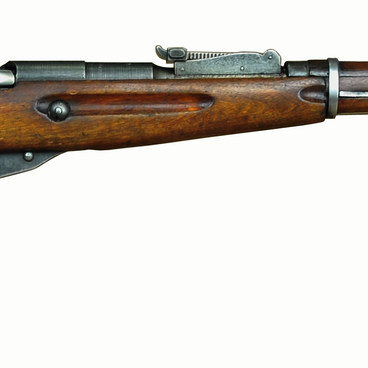Early firearms used separate loading ammunition. At first, a propellant charge was loaded from the muzzle of the gun and sealed with wadding made from felt or tow. After that, a round lead bullet was rolled in and secured with another wadding. Finally, more gunpowder or priming powder was added to the flash pan with an ignition hole. In order to fire the gun, a shooter had to ignite the priming powder.
In the early 19th century, a primer was invented — it was a cap containing a flammable mixture, which was struck by the hammer to set off the gunpowder charge. In the mid-19th century, a single-piece cartridge was invented — it contained a bullet, gunpowder, and a primer in a paper sleeve. At the same time, a new loading method was invented — the cartridge was loaded via the rear (breech) end of the barrel. Cartridges and breechloaders were successfully used during the 1866 Austro-Prussian war, and European armies switched to breech-loading rifles.
In the 1860s, the Ministry of War of the Russian Empire was also looking for a way to quickly replace the outdated 6-line muzzle-loading rifles designed in 1856 and 1858. The experts chose a breech-loading system that could easily be used to transform the existing weapons.
Initially, from 1866 to 1868, muzzle-loading rifles were converted to use paper cartridges according to the Terry-Norman and Carle systems. Later, the Putilov Plant in St. Petersburg was instructed to modernize rifles in order to use metal case cartridges designed by Lieutenant Nikolay Baranov. The ministry was also informed about the system developed by the Austrian gunsmith of Czech origin Sylvester Krnka. The commission carried out a comparative study of the weapon prototypes by Baranov and Krnka and concluded that the costs of remodeling according to Krnka’s system were 25% lower. On March 18, 1869, based on the test results, Krnka’s system was approved for rifles with metal case cartridges.
The rifle consisted of a steel round barrel with a receiver and a bolt, a firing mechanism, a stock, a sighting device, gun furniture, and a steel gun stick. The stock was made of wood and included the fore-end and the butt-end. The barrel was attached to the stock with three clips, or bands, and a rear screw. A receiver with a bolt attached to it was screwed onto the breech end of the barrel. The back of the receiver was attached to the stock with a shank.
In the early 19th century, a primer was invented — it was a cap containing a flammable mixture, which was struck by the hammer to set off the gunpowder charge. In the mid-19th century, a single-piece cartridge was invented — it contained a bullet, gunpowder, and a primer in a paper sleeve. At the same time, a new loading method was invented — the cartridge was loaded via the rear (breech) end of the barrel. Cartridges and breechloaders were successfully used during the 1866 Austro-Prussian war, and European armies switched to breech-loading rifles.
In the 1860s, the Ministry of War of the Russian Empire was also looking for a way to quickly replace the outdated 6-line muzzle-loading rifles designed in 1856 and 1858. The experts chose a breech-loading system that could easily be used to transform the existing weapons.
Initially, from 1866 to 1868, muzzle-loading rifles were converted to use paper cartridges according to the Terry-Norman and Carle systems. Later, the Putilov Plant in St. Petersburg was instructed to modernize rifles in order to use metal case cartridges designed by Lieutenant Nikolay Baranov. The ministry was also informed about the system developed by the Austrian gunsmith of Czech origin Sylvester Krnka. The commission carried out a comparative study of the weapon prototypes by Baranov and Krnka and concluded that the costs of remodeling according to Krnka’s system were 25% lower. On March 18, 1869, based on the test results, Krnka’s system was approved for rifles with metal case cartridges.
The rifle consisted of a steel round barrel with a receiver and a bolt, a firing mechanism, a stock, a sighting device, gun furniture, and a steel gun stick. The stock was made of wood and included the fore-end and the butt-end. The barrel was attached to the stock with three clips, or bands, and a rear screw. A receiver with a bolt attached to it was screwed onto the breech end of the barrel. The back of the receiver was attached to the stock with a shank.

